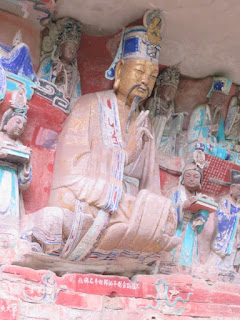 |
| Entrance to Dazu Grotto |
We woke at 5 am and
put our bags out for the porter to load into the truck for our trip to Chengdu. We
went to breakfast with Mark and Cindy around 6:15 and had a very good meal of
mostly local breakfast items. Bacon, eggs, toast and cereal as well as other
Western breakfast choices were available but we usually ate Chinese as much as
possible. Mary has really come to enjoy
the bao which are dumplings filled with meats or bean paste. I look forward to the steamed black rice and
the Chinese yams and sweet potatoes.
Although the terms yam and sweet potato are used interchangeably in the
US, they are very different foods from different types of plants from different
parts of the world. Fortunately, we had
access to both at most breakfasts here in China.
The light rain had
gotten heavier and we knew that our rain gear was in our checked bags, but Cindy
and I were able to catch the porters before our bags were loaded onto the truck
and retrieved our jackets. Patrick wanted to get an early start because holiday
traffic was expected to be heavy, and we wanted to be at the Dazu
Grotto in time to see the carvings.
After about a two hour
drive in the rain we arrived at the Dazu
Grotto. We walked a short distance then boarded golf carts to go to what
would be called a hollow or canyon in the US. We were treated to hundreds of
elaborate carvings in the limestone. The carvings were started over 1400 years
ago but have continued by faithful Buddhists over the centuries. Detailed
panels depict Buddhist gods, prophets and disciples. Interpretations of Heaven
and Hell teach the consequences of good and bad behavior. Carvings illustrate
how good Buddhists should live. There
are also depictions from Confucian and Taoist teaching. This illustrates the
blending of these belief systems that is so common throughout much of China.
The beauty and
craftsmanship of the panels were amazing enough but considering that the panels
have been in place for over a millennium is even more impressive. During the
Cultural Revolution Communist Chinese soldiers destroyed religious artifacts
and locations on orders from Chairman Mao. However, farmers in the area who
realized the importance of Dazu Grotto did not tell the soldiers about it. The
remote location of the carvings in the hollow did not let the soldiers have a
clue that they were there.
We were amazed with
the detail and size of the carvings. We
thought there would be a few old statues, but we were treated to over 50,000
statues in the rock walls of Dazu Grotto.
Although the carvings started around 650 AD during the Tang Dynasty the
work there continued until 1911 in the Qing Dynasty.
The Dazu Grotto was
designated as a UNESCO World
Heritage site in 1999. Until then the site was closed to all foreigners.
Only Chinese Buddhists could come here to worship before 1999. Even when we
were there most of the visitors were Chinese. Many visitors kneeled down to
pray before the carvings. It was quite impressive and was one of the highlights
of the trip. Even though we had to walk around the grotto in a steady rain, it
was still a memorable visit.
We walked back to the
bus in the rain then rode for three hours to get to Chengdu. This city of over
16 million is probably best known to westerners because of the Szechwan or Sichuan
style of Chinese food from this area. Although there are several things that we
want to learn about Chengdu, we certainly want to try the local Sichuan cooking.
We arrived at the St.
Regis Chengdu at 5:30. Patrick needed our passports to check us in and he
had our room keys ready for us when we arrived. When we got to the rooms our
bags were already in the rooms which were spectacular. We have a huge bedroom
with a king size bed, two desks, a multidirectional shower, a fully automated
bidet, a television with Bose sound that sinks into the desk and automated
lights and curtains. Our corner room looks out on a beautiful view of the city.
We dressed for dinner
but decided to step over to the McDonald's across the street. They had a number
of local Chinese and Sichuan choices available. Mark and Cindy tried some
popcorn chicken and fries to see how they are different from McDonalds in the
US.
We went to dinner at
the St. Regis a little after 7 pm and had a large array of Chinese and
specifically Sichuan choices. We had several meat and vegetable choices as well
as fruits and cheeses. Mary and Cindy finished with a coconut crème brule. We
all enjoyed our meals. We went up to get some sleep since we leave for a visit
to the museum in Chengdu at 8 am.





No comments:
Post a Comment